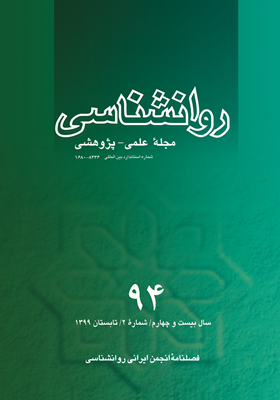نقش تعديل کنندگی همدلی در رابطه بين قضاوت اخلاقی و رفتار اخلاقی در دانشآموزان
محورهای موضوعی : روانشناسی
زینب رضایی
1
,
الهه حجازی
2
![]() ,
حسین کارشکی
3
,
حسین کارشکی
3
1 - دانشکده روانشناسی و علوم تربیتی، دانشگاه تهران
2 - دانشکده روانشناسی و علوم تربیتی، دانشگاه تهران
3 - دانشکده علوم تربیتی و روانشناسی دانشگاه فردوسی مشهد
کلید واژه: رفتار اخلاقی, قضاوت اخلاقی, تحول اخلاقی, همدلی, تعديل کننده,
چکیده مقاله :
هدف از اين پژوهش تعيين نقش تعديل گري همدلي در رابطه بين قضاوت اخلاقي و رفتار اخلاقي دانش آموزان است. براي اين منظور 336 نفر از دانش آموزان پاية هشتم شهر مشهد به روش نمونه گيري خوشه اي چند مرحله اي انتخاب شدند. ابزارهاي مورد استفاده در اين پژوهش عبارتند از: فهرست 15 سؤالي رفتار اخلاقي سوانسون و هيل (1993)، داستان هاي اخلاقي رست و همکاران (1973) براي سنجش قضاوت اخلاقي و همچنين پرسشنامه همدلي مارک ديويس (1994). آزمون هاي مختلف استنباطي همچون همبستگي پيرسون و رگرسيون سلسله مراتبي جهت بررسي يافته ها مورد استفاده قرار گرفت. نتايج پژوهش نشان داد بين قضاوت اخلاقي و رفتار اخلاقي رابطة معنادار، مستقيم اما ضعيفي وجود دارد. همچنين همدلي با رفتار اخلاقي رابطة مثبت و معناداري دارد. تحليل رگرسيون نشان داد همدلي بر رابطه بين قضاوت اخلاقي و رفتار اخلاقي اثر تعديل کنندگي دارد. همچنين تفاوت جنس دردو مورد خرده مقياس هاي نگراني همدلانه و ديدگاه گيري مشاهده شد. با توجه به نتايج مي توان گفت نه تنها رفتار اخلاقي دانش آموزان به گونة مستقيم از راه قضاوت اخلاقي قابل پيش بيني است بلکه اين رابطه از راه همدلي نيز تعديل مي شود.
The aim of this study is to investigate the role of moderating of empathy in the relationship between moral judgment and moral behavior of students. For this purpose, 336 students (176 girls and 160 boys) at high school the eighth Grade students in Mashhad were selected using multistage cluster sampling. Tools used in this research were: 15 Questions Checklist Moral Behavior of Swanson and Hill (1993), the short form of Moral Stories of Rest and colleagues (1973), for Moral Judgment, and Empathy Questionnaire of Mark Davies (1994). Different analytical tests including Pearson correlation and hierarchical regression were used to examine the findings The results showed that there is a significant, direct but weak relationship between moral judgment and moral behavior. also there is a positive and significant relationship between empathy and moral behavior. Regression analysis showed empathy has a moderating effect on the relationship between moral judgment and moral behavior, also, the gender differences in two empathic concern and perspective-taking subscales was observed. According to the results, it can be said that not only students’ moral behavior is directly predictable from moral judgment, but also this relationship is being moderated through empathy.


